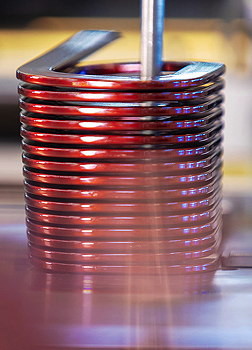Air gaps that form in the spaces between windings of coils can occupy to 9% of the space, and these gaps are up to 24 times less electrically active than the copper.
The new edge-winding technique produces coils with lower skin effect and proximity losses than traditional winding techniques. The edge-wound coils also exhibit lower parasitic capacitance than other methods of winding, reducing unwanted high-frequency return paths, and helping to ensure electromagnetic compatibility (EMC).
The single-layered structure of the edge-wound coils allows heat to be dissipated more efficiently, which is particularly useful in applications requiring water-cooling or likely to operate under high levels of mechanical and thermal stress.
“Not only does the new technique offer REO products greater heat dissipation and lower losses,” says Steve Hughes, managing director of REO's operation in the UK. “It also allows us to optimise each product to meet the technical and budgetary requirements of customers. The improved cooling makes it feasible to use aluminium and copper conductors, providing more flexibility in meeting technical demands.”

REO’s edge-winding technology results in wound components with much lower losses than normal
REO is continuing to develop the edge-winding technology. At present, the technique is best suited to products carrying currents of 50–250A. The company is working on new combinations of windings that will allow this to be raised in the future.

